Key takeaways:
- Understanding family dynamics is crucial for navigating relationships, especially during emotionally charged events like weddings.
- Open communication and setting boundaries can foster a sense of inclusion and reduce misunderstandings among family members.
- Involving family in specific tasks and honoring traditions can enhance their investment in shared experiences, creating lasting memories.
- Emotional honesty during discussions encourages vulnerability, leading to deeper connections and a collaborative atmosphere.
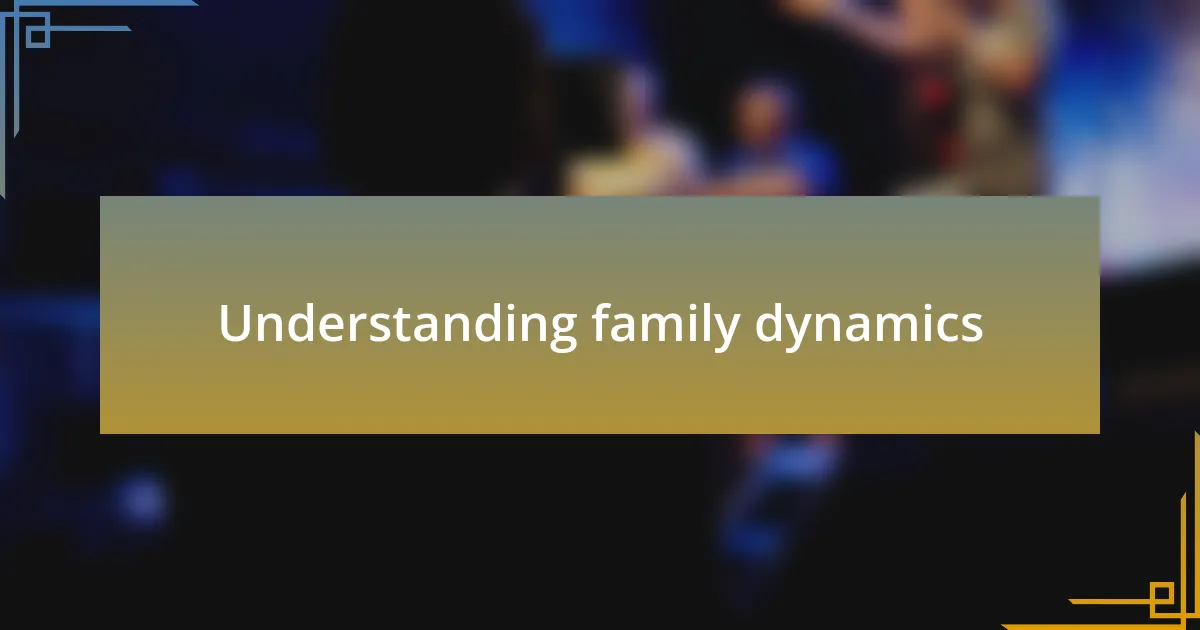
Understanding family dynamics
Family dynamics can be complicated, often shaped by individual personalities and histories. I remember a family gathering where differing opinions led to a tense dinner. It made me wonder—how can we navigate these waters without sinking our relationships?
As I reflect on my own experiences, I realize that understanding our family’s history can provide essential context for current behaviors. For instance, the way my parents communicated taught me about conflict resolution. It left me grappling with the question: how much do our backgrounds dictate our interactions with one another?
Navigating family dynamics is like learning a new dance; it requires patience, understanding, and sometimes even stepping on toes. I often find myself observing how certain family members take charge during gatherings, while others prefer to remain in the background. This raises an intriguing thought: how do we encourage quieter members to share their voices without compromising the overall harmony?

Importance of family in weddings
When it comes to weddings, family serves as a backbone that supports the emotional weight of the day. During my own wedding planning, I was surprised by how much my family’s involvement shaped the experience. Their excitement and support infused the event with warmth, making it not just a celebration of love but also a gathering of shared histories and connections.
Family plays a pivotal role in wedding traditions and customs, often serving as a bridge between generations. I recall how my grandmother shared the significance behind certain traditions, allowing me to appreciate their roots. It struck me that these rituals not only honor our ancestors but also strengthen our bonds, as we come together to create new memories while respecting the past.
Moreover, the presence of family can act as an emotional safety net. I remember standing nervously at the altar and glancing at my family, their smiles reassuring me. It made me think—how much more meaningful is a wedding day when surrounded by those who have supported you through life’s ups and downs? Their love and encouragement seem to amplify the joy of the occasion, creating an experience that feels shared rather than solitary.
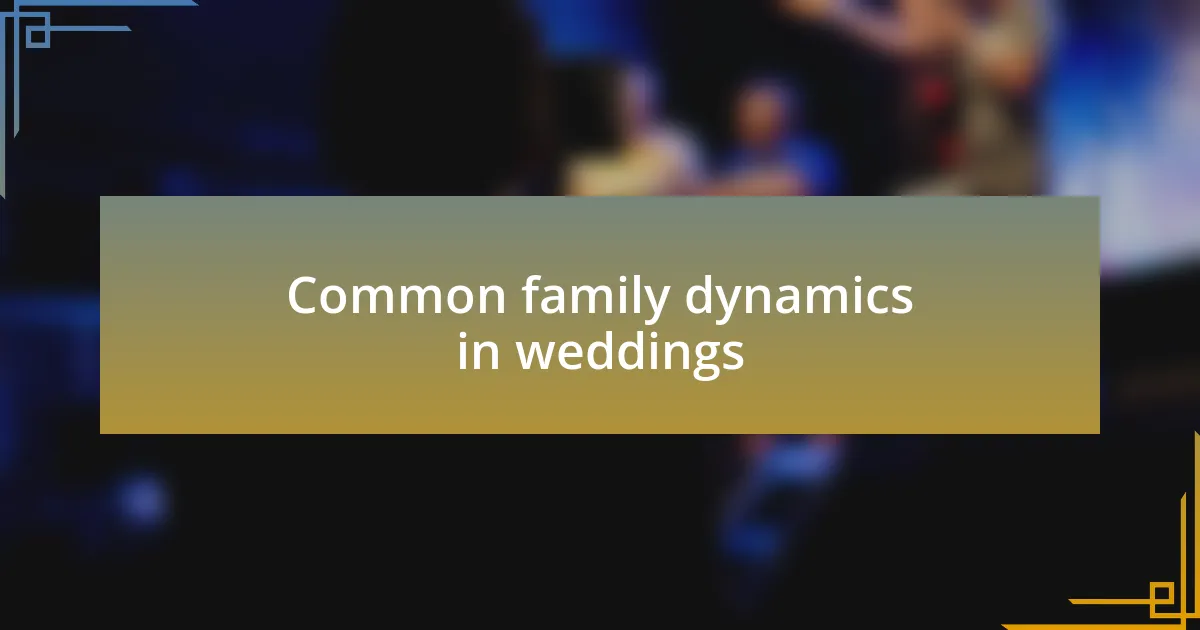
Common family dynamics in weddings
Family dynamics at weddings can often be a complex tapestry woven with varied emotions and expectations. I remember during the planning process, my siblings and I had differing opinions on guest lists, leading to some lively debates. It made me realize how weddings can bring out both unity and tension, as different personalities clash and align in the pursuit of a shared vision.
There’s also the subtle (and sometimes not-so-subtle) dance between in-laws and immediate family. I witnessed moments where my parents tried to connect with my partner’s family, which felt both heartening and awkward. These interactions highlight an interesting question: how do we balance the needs and traditions of two separate families while still honoring our own?
Additionally, wedding responsibilities often fall into established roles within the family, which can be both a blessing and a burden. I found that assigning tasks to family members—like my cousin taking charge of the music—helped ease my stress, but it also revealed who thrived under pressure and who buckled. Such dynamics can deepen family bonds but also expose underlying tensions. How do you navigate these roles while keeping the joy of the occasion in focus?
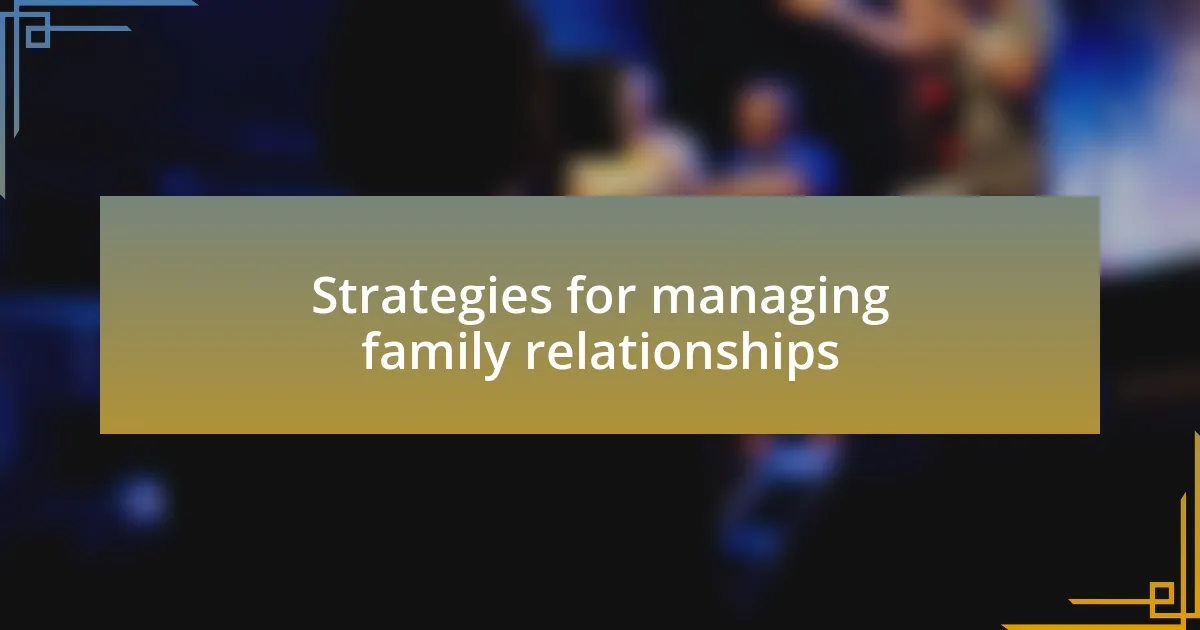
Strategies for managing family relationships
When managing family relationships, I found that open communication was a vital strategy. I remember sitting down with my family to discuss our wedding vision, ensuring everyone felt heard. This approach not only minimized misunderstandings but also fostered a sense of inclusion among family members. Have you ever felt the relief that comes from simply discussing expectations openly? It’s transformative.
Setting boundaries was another essential tactic for me. I realized that while everyone had their opinions, some discussions needed a clear limit. For instance, I gently redirected conversations when they veered into areas that caused conflict. It became a practice of respect for our choices, allowing us to celebrate without the weight of constant critiques. How often do you think boundaries can shape healthier family dynamics? They certainly made a difference in my experience.
Lastly, finding common ground can create a nurturing environment amidst differences. During one family gathering, we all shared our favorite wedding traditions from our cultural backgrounds, which sparked warmth and laughter. This exchange reminded us that, while we may not see eye to eye on everything, we all cherish the love that brought us together. Have you experienced moments like this where shared joy helped bridge gaps? It’s in those connections that I found the essence of family unity.
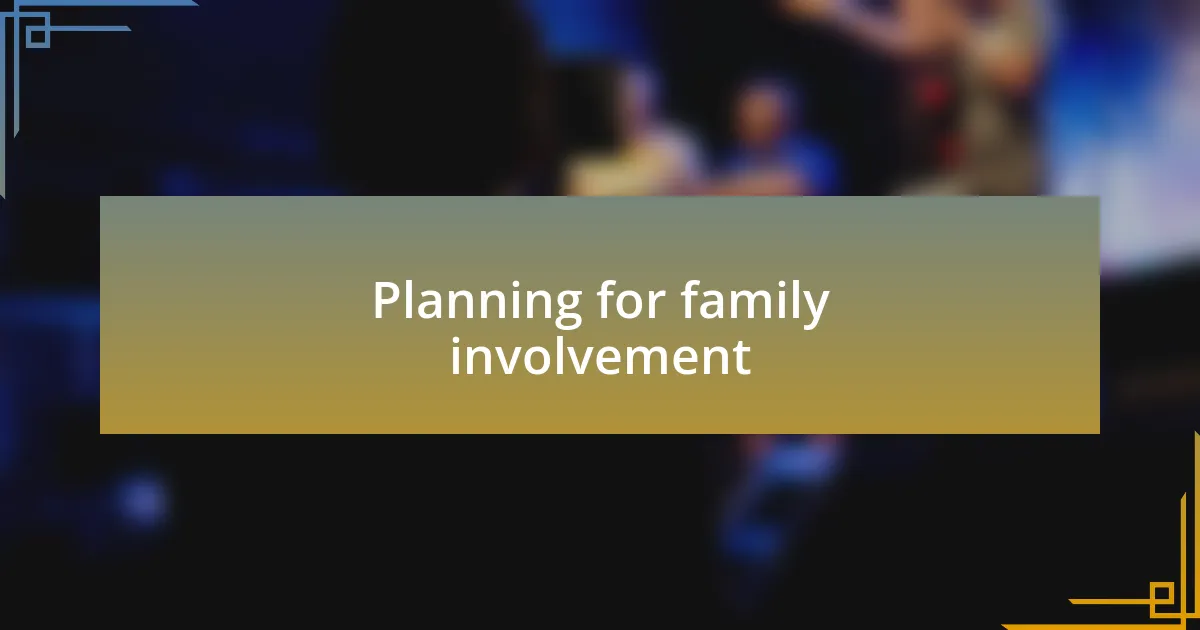
Planning for family involvement
Planning for family involvement is a balancing act that requires attention and sensitivity. I recall a moment when my fiancé and I decided to invite both sides of our families to participate in picking out certain elements, like the wedding colors. The excitement in the room was palpable, and it was rewarding to see family members contributing ideas, making them feel invested in our big day. Have you ever noticed how including family can shift the atmosphere from tension to joy? It’s remarkable.
One effective approach I found was involving family members in specific tasks rather than overwhelming them with every decision. For example, I asked my sister to be in charge of the floral arrangements, as she had a knack for design. By giving her this responsibility, I not only honored her creative spirit but also lightened our load. Doesn’t it feel good when family members step up and contribute their strengths? It transformed our planning process into a collaborative effort rather than a chore.
Additionally, I learned to celebrate family traditions that could unify everyone. During a family meeting, we decided to incorporate a special song from my partner’s heritage into the ceremony. The joy on his mother’s face was unforgettable and reminded me how powerful it is to embrace diverse backgrounds. Have you ever thought about how a meaningful gesture can bring families closer together? It’s those moments of connection that create lasting memories.
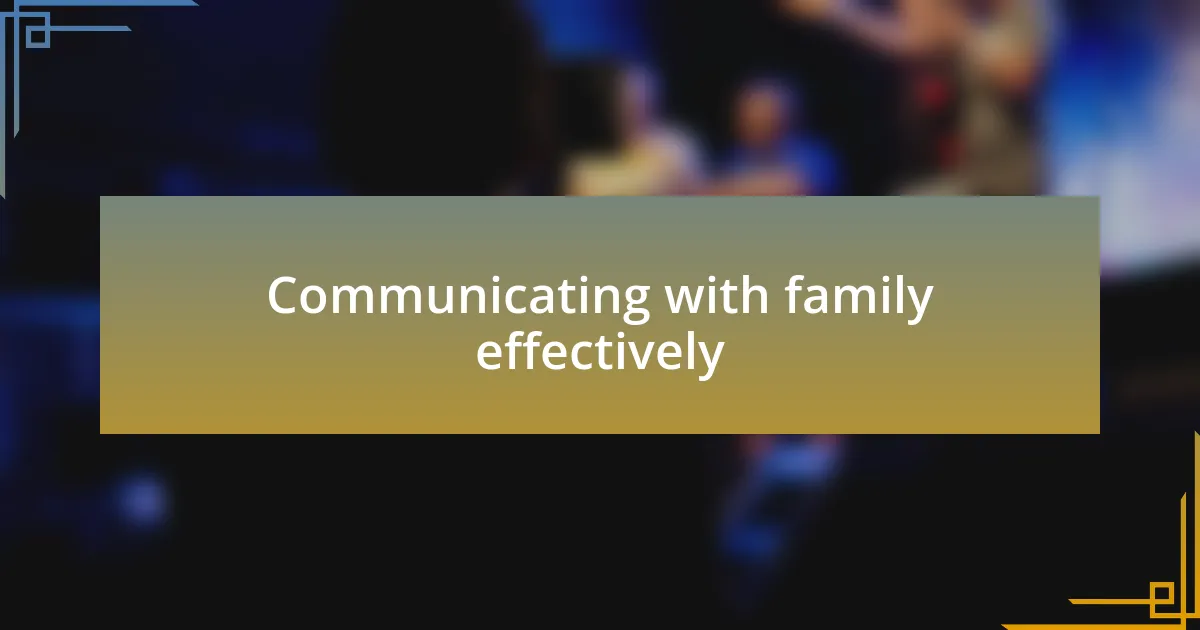
Communicating with family effectively
Effective communication with family can feel like navigating a maze, but I’ve found that simplicity often works best. I remember when I gathered my family to discuss our wedding plans; it was a bit chaotic at first. Instead of throwing a barrage of ideas at them, I made it a point to ask open-ended questions, like, “What are your thoughts on the seating arrangements?” This not only encouraged everyone to share but also fostered a sense of inclusion that eased any initial tension.
One technique that truly transformed our discussions was meeting in informal settings. Over dinner one night, I proposed we talk about our ideas in a relaxed and enjoyable atmosphere. I noticed how much more freely everyone contributed; laughter mixed with ideas often led to creative inspirations we might not have captured in a formal meeting. Have you ever experienced the difference a change in scenery can make? It can turn what feels like an obligation into an exciting exploration.
Emotional honesty is also vital during these conversations. I remember sharing my own fears about pleasing everyone, and that moment of vulnerability opened the floodgates for others to express their feelings too. It became a safe space where everyone felt heard and valued. When was the last time you were candid about your emotions in a family discussion? It can shift the dynamics completely, creating an environment where understanding flourishes and the goal of collaborating becomes a shared journey.
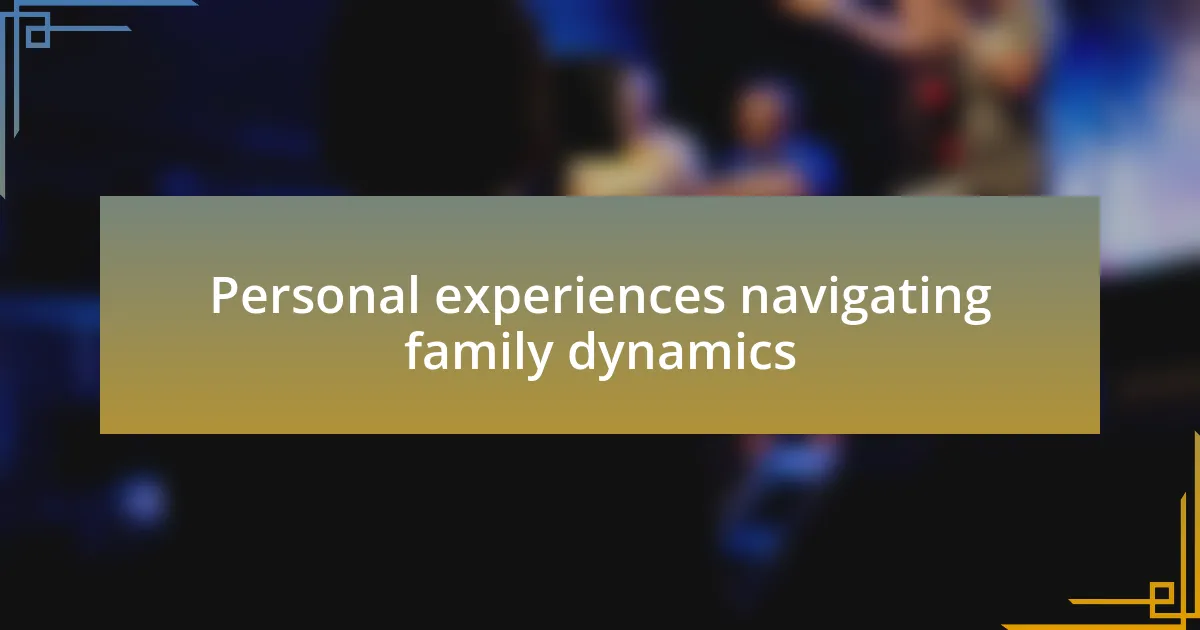
Personal experiences navigating family dynamics
Navigating family dynamics during wedding planning brought some unexpected challenges. I recall our first attempt at a group chat; everyone had strong opinions and there was a lot of back and forth that felt overwhelming. It struck me how important it was to create boundaries. I suggested we tackle one topic at a time, and that simple framework made discussions feel less combative and more collaborative. Have you ever found that focusing on a single issue can lead to clarity?
One memorable moment for me was during a family gathering when my cousin began to share her experiences from her own wedding planning. She openly discussed the conflicts she faced, which resonated with many of us. That sharing created a bond and reminded me that we’re often more alike than different, especially when it comes to family pressures. I found myself more at ease after realizing that vulnerability isn’t a weakness but a powerful tool for connection.
One lesson I cherished throughout this process is the necessity of patience. I often felt anxious when decisions took longer than I anticipated. However, allowing the time for everyone to voice their opinions ultimately led to a richer, more inclusive wedding vision. I realized that sometimes it’s less about the timeline and more about the journey together. How can we embrace the pace of family dynamics while still moving forward? It’s that balance between urgency and connection that often shapes the best memories.